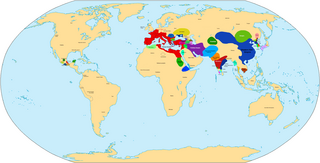
The 20s decade ran from January 1, AD 20, to December 31, AD 29.

The 30s decade ran from January 1, AD 30, to December 31, AD 39.

The 40s decade ran from January 1, AD 40, to December 31, AD 49.
AD 4 was a common year starting on Wednesday or a leap year starting on Tuesday of the Julian calendar and a leap year starting on Tuesday of the Proleptic Julian calendar. In the Roman Empire, it was known as the Year of the Consulship of Catus and Saturninus. The denomination "AD 4" for this year has been used since the early medieval period, when the Anno Domini calendar era became the prevalent method in Europe for naming years.
6 was a common year starting on Friday of the Julian calendar. In the Roman Empire, it was known as the Year of the Consulship of Lepidus and Lucius Arruntius. The denomination "AD 6" for this year has been used since the early medieval period, when the Anno Domini calendar era became the prevalent method in Europe for naming years.

Year 44 BC was either a common year starting on Sunday, common year starting on Monday, leap year starting on Friday, or leap year starting on Saturday. and a common year starting on Sunday of the Proleptic Julian calendar. At the time, it was known as the Year of the Consulship of Julius Caesar V and Marc Antony. The denomination 44 BC for this year has been used since the early medieval period, when the Anno Domini calendar era became the prevalent method in Europe for naming years.

This article concerns the period 49 BC – 40 BC.

This article concerns the period 59 BC – 50 BC.
This article concerns the period 69 BC – 60 BC.
80s BC is the time period from 89 BC – 80 BC.
This article concerns the period 19 BC – 10 BC.
Year 59 BC was a year of the pre-Julian Roman calendar. At the time, it was known as the Year of the Consulship of Caesar and Bibulus. The denomination 59 BC for this year has been used since the early medieval period, when the Anno Domini calendar era became the prevalent method in Europe for naming years.

The Ides of March is the 74th day in the Roman calendar, corresponding to 15 March. It was marked by several religious observances and was a deadline for settling debts in Rome. In 44 BC, it became notorious as the date of the assassination of Julius Caesar, which made the Ides of March a turning point in Roman history.
Year 47 BC was a year of the pre-Julian Roman calendar. At the time, it was known as the Year of the Consulship of Calenius and Vatinius. The denomination 47 BC for this year has been used since the early medieval period, when the Anno Domini calendar era became the prevalent method in Europe for naming years.

Year 50 BC was a year of the pre-Julian Roman calendar. At the time, it was known as the Year of the Consulship of Paullus and Marcellus. The denomination 50 BC for this year has been used since the early medieval period, when the Anno Domini calendar era became the prevalent method in Europe for naming years.
Year 63 BC was a year of the pre-Julian Roman calendar. At the time it was known as the Year of the Consulship of Cicero and Hybrida. The denomination 63 BC for this year has been used since the early medieval period, when the Anno Domini calendar era became the prevalent method in Europe for naming years.
Year 304 BC was a year of the pre-Julian Roman calendar. At the time, it was known as the Year of the Consulship of Sophus and Saverrio. The denomination 304 BC for this year has been used since the early medieval period, when the Anno Domini calendar era became the prevalent method in Europe for naming years.

The pontifex maximus was the chief high priest of the College of Pontiffs in ancient Rome. This was the most important position in the ancient Roman religion, open only to patricians until 254 BC, when a plebeian first held this position. Although in fact the most powerful office in the Roman priesthood, the pontifex maximus was officially ranked fifth in the ranking of the highest Roman priests, behind the rex sacrorum and the flamines maiores.
AD 2 (II) or 2 AD was a common year starting on Sunday or Monday of the Julian calendar and a common year starting on Sunday of the proleptic Julian calendar. In the Roman Empire, it was known as the Year of the Consulship of Vinicius and Varus, named after Roman consuls Publius Vinicius and Alfenus Varus, and less frequently, as year 755 AUC within the Roman Empire. The denomination "AD 2" for this year has been used since the early medieval period, when the Anno Domini calendar era became the prevalent method in Europe for naming years.

The 0s began on January 1, AD 1 and ended on December 31, AD 9, covering the first nine years of the Common Era. It is one of two "0-to-9" decade-like timespans that contain nine years, along with the 0s BC.








